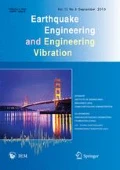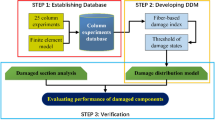Abstract
To meet the demand for an accurate and highly efficient damage model with a distinct physical meaning for performance-based earthquake engineering applications, a stiffness degradation-based damage model for reinforced concrete (RC) members and structures was developed using fiber beam-column elements. In this model, damage indices for concrete and steel fibers were defined by the degradation of the initial reloading modulus and the low-cycle fatigue law. Then, section, member, story and structure damage was evaluated by the degradation of the sectional bending stiffness, rod-end bending stiffness, story lateral stiffness and structure lateral stiffness, respectively. The damage model was realized in Matlab by reading in the outputs of OpenSees. The application of the damage model to RC columns and a RC frame indicates that the damage model is capable of accurately predicting the magnitude, position, and evolutionary process of damage, and estimating story damage more precisely than inter-story drift. Additionally, the damage model establishes a close connection between damage indices at various levels without introducing weighting coefficients or force-displacement relationships. The development of the model has perfected the damage assessment function of OpenSees, laying a solid foundation for damage estimation at various levels of a large-scale structure subjected to seismic loading.
Similar content being viewed by others
References
Amziane S and Dubé J-F (2008), “Global RC Structural Damage Index-based on The Assessment of Local Materia l Damage,” Journal of Advanced Concrete Technology, 6(3): 459–468.
Calabrese A, Almeida JP and Pinho R (2010), “Numerical Issues in Distributed Inelasticity Modeling of RC F rame Elements for Seismic Analysis,” Journal of Earthquake Engineering, 14(Sup1): 38–68.
Chang GA and Mander JB (1994), “Seismic Energybased Fatigue Damage Analysis of Bridge Columns: Part I-Evaluation of Seismic Capacity,” NCEER-94-0006, U.S. National Center for Earthquake Engineering Research, Buffalo, N.Y.
Chopra AK (1995), Dynamics of Structures, Prentice Hall, Upper Saddle River, N.J.
Dodd L and Restrepo-Posa da J (1995), “Model for Predicting Cyclic Behavior of Reinforcing Steel,” Journal of Structural Engineering, 121(3): 433–445.
Ghobarah A (2001), “Performance-based Design in Earthquake Engineering: State of Development,” Engineering Structures, 23(8): 878–884.
Ghobarah A, Abou-Elfath H and Biddah A (1999), “Response-based Damage Assessment of Structures,” Earthquak e Engineering & Structural Dynamics, 28(1): 79–104.
Heo Y (2009), “Framework for Damage-based Probabilistic Seismic Performance Evaluation of Reinforced Concr ete Frames,” Ph.D. Thesis, University of California, Davis, Ann Arbor, 201 pp.
Hindi RA and Sexsmith RG (2001), “A Proposed Damage Model for RC Bridge Columns under Cyclic Loading,” Ear thquake Spectra, 17(2): 261–290.
Hsu TT and Mo Y-L (2010), Unified Theory of Concrete Structures, John Wiley & Sons, Hoboken.
Koh S and Stephens R (1991), “Mean Stress Effects on Low Cycle Fatigue for a High Strength Steel,” Fatigue & Fracture of Engineering Materials & Structures, 14(4): 413–428.
Kostic S and Filippou F (2012), “Section Discretization of Fiber Beam-column Elements for Cyclic Inelastic Response,” Journal of Structural Engineering, 138(5): 592–601.
Kunnath SK, El-Bahy A, Taylor AW and Stone WC (1997), “Cumulative Seismic Damage of Reinforced Concrete Br idge Piers,” Technical Report NCEER, US National Center for Earthquake Engineering Research, Buffalo, 89-106.
Li G, Zhang Y and Li H (2013), “Seismic Damage Analysis of Reinforced Concrete Frame Using the Force Analo gy Method,” Journal of Engineering Mechanics, 139(12): 1780–1789.
Li S, Zhai C and Xie L (2012), “Evaluation of Displacement-based, Force-based and Plastic Hinge Elements for Structural Non-linear Static Analysis,” Advances in Structural Engineering, 15(3): 477–488.
Li Z, Chen Y and Li N (2014), “A Damage Model for Reinforced Concrete Members Based on Material Damage,” E ngineering Mechanics, 31(06): 53–59. (in Chinese)
Li Z, Teng J and He X (2011), “Seismic Damage Analysis Model for RC Structures Based on Concrete Plastic D amage Model,” Proceedings of the Structures Congress 2011, Las Vegas, 2768–2779.
Lu X, Ye L, Pan P, Tang D and Qian J (2012a), “Pseudostatic Collapse Experiments and Numerical Prediction Competition of RC Frame Structure II: Key Elements Experiment,” Building Structure, 42(11): 23–26. (in Chinese)
Lu X, Ye L, Pan P, Zhao Z, Ji X and Qian J (2012b), “Pseudo-static Collapse Experiments and Numerical Predi ction Competition of RC Frame Structure I: RC frame experiment,” Building Structure, 42(11): 19–22, 26. (in Chinese)
Maas S, Zürbes A, Waldmann D, Waltering M, Bungard V and De Roeck G (2012), “Damage Assessmen t of Concrete Structures through Dynamic Testing Methods. Part 1–Laboratory Tests,” Engineering Structures, 34(2012): 351–362.
Mansour M, Lee J-Y and Hsu TT (2001), “Cyclic Stress- Strain Curves of Concrete and Steel Bars in Membrane Elements,” Journal of Structural Engineering, 127(12): 1402–1411.
Mazzoni S, Mc Kenna F, Scott MH and Fenves GL (2006), OpenSees Command Language Manual, Pacific Earthquake Engineering Research (PEER) Center Berkeley.
Miner MA (1945), “Cumulative Damage in Fatigue,” Journal of Applied Mechanics, 12: A159–A164.
Park Y and Ang A (1985), “Mechanistic Seismic Damage Model for Reinforced Concrete,” Journal of Structural Engineering, 111(4): 722–739.
Saatcioglu M and Grira M (1999), “Confinement of Reinforced Concrete Columns with Welded Reinforced Grids,” ACI Structural Journal, 96(1): 29–39.
Teng J, Li Z, Ou J and He X (2011), “Fiber Damage Analysis Model for RC Beam-column Based on EEP Super-con vergent Computation,” Science China Technological Sciences, 54(10): 2542–2548.
Tsuchiya S and Maekawa K (2006), “Cross-sectional Damage Index for RC Beam-column Members Subjected to Mul ti-axial Flexure,” Journal of Advanced Concrete Technology, 4(1): 179–192.
Van Paepegem W, Dechaene R and Degrieck J (2005), “Nonlinear Correction to the Bending Stiffness of a Dama ged Composite Beam,” Composite Structures, 67(3): 359–364.
Waugh JD (2011), “Nonlinear Analysis of T-shaped Concrete Walls Subjected to Multi-directional Displacemen ts,” Ph.D. Thesis, Iowa State University, Ames, 294 pp.
Welfert B (2010), “A Note on Classical Gauss–radau and Gauss–lobatto Quadratures,” Applied Numerical Mathe matics, 60(6): 637–644.
Xie L, Lu X, Guan H and Lu X (2015), “Experimental Study and Numerical Model Calibration for Earthquake-Induced Collapse of RC Frames with Emphasis on Key Columns, Joints, and the Overall Structure,” Journal of Earthquake Engineering, 19(8): 1320–1344.
Yazgan U and Dazio A (2012), “Post-earthquake Damage Assessment Using Residual Displacements,” Earthquake Engineering & Structural Dynamics, 41(8): 1257–1276.
Author information
Authors and Affiliations
Corresponding author
Additional information
Supported by: the National Natural Science Foundation of China under Grant Nos. 51278218 and 51078166
Rights and permissions
About this article
Cite this article
Guo, Z., Zhang, Y., Lu, J. et al. Stiffness degradation-based damage model for RC members and structures using fiber-beam elements. Earthq. Eng. Eng. Vib. 15, 697–714 (2016). https://doi.org/10.1007/s11803-016-0359-4
Received:
Accepted:
Published:
Issue Date:
DOI: https://doi.org/10.1007/s11803-016-0359-4




